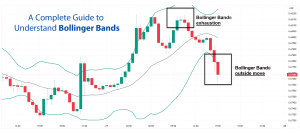Understanding Bollinger Bands: A Comprehensive Guide for Traders
In the world of trading, Technical analysis tools are inconceivable in the world of trading. Among the technical analysis tools, the Bollinger Bands is one of the most popular and versatile indicators. Whether one is a long-term investor or a retail trader, adding knowledge about Bollinger Bands substantially improves one’s trading strategy. This will explain what Bollinger Bands are, how they work, and how to use them to further improve your trading outcomes.
What Are Bollinger Bands?
Bollinger Bands are one type of technical analysis tool, consisting of three lines plotted on a price chart. These bands have been devised to serve traders with the purpose of estimating volatility in markets and the resultant price movements.
- Definition: Bollinger Bands consist of three lines.
- Middle Band: That forms a 20-period SMA of the closing prices.
- Upper Band: The upper band is derived as adding twice the standard deviation of the closing prices from the middle band.
- Lower Band: The lower band is found by subtracting twice the standard deviation from the middle band.
- Historical Background: Invented by John Bollinger in the 1980s, Bollinger Bands played an indispensable role in technical analysis and were well adapted for measuring volatility and finding trading opportunities.
- Mathematical Basis: The bands self-regulate with any changes in the market conditions: during a market that is less volatile, the bands contract, while highly volatile markets see the bands expand.
How Bollinger Bands Work
Perhaps a further look at what is behind Bollinger Bands and what inferences might be made from them about market behavior could be of use.
- The Middle Band: The middle band, or SMA, is an average price over a certain period in time. The base for the upper and lower bands.
- The Upper and Lower Bands: The bands are plotted two standard deviations above and below the middle band. The width between the bands widens and constricts with the volatility of the market:
- Narrow Bands: Indicate low volatility and possible breakout.
- Wide Bands: Point to high volatility and, probably, price reversals.
- Band Width: The width of the bands is a major indicator. A contraction of the bands, also called a “squeeze,” is most times followed by a big price movement. On the other hand, an expansion could mean that a trend is ongoing.
Interpreting Bollinger Bands
Correct interpretation of Bollinger Bands helps a trader in making better decisions.
- Price Movement Within the Bands: Prices moving within the bands generally show that the market is stable. A price that has continuously traveled in proximity to the upper band may indicate overbought conditions, while a price near the lower band could indicate an oversold state.
- Squeeze: A squeeze would occur when bands contract, thus giving a breakout signal. Generally, traders seek a price move that breaks out of the squeeze for trading opportunities.
- Breakouts: It can also be a sign of high momentum at times when prices move outside of the bands. These breakouts have to be confirmed by other indicators in order to avoid false ones.
Trading Strategies Using Bollinger Bands
Bollinger Bands are used by traders in a number of different ways to exploit market opportunities.
- Trend Following Strategy: Traders may look to trade in the direction of the trend when the price consistently touches or moves along one of the bands. For example, buying when prices touch the lower band and selling when they touch the upper band.
- Reversal Strategy: Prices outside the bands can also suggest possible reversals. One final use of confirmation signals is to provide a trigger for the entry point of a trade to take place in a direction opposite to that of the breakout.
- Combination with Other Indicators: Combining Bollinger Bands with other indicators, such as the RSI or MACD, may provide a more enhanced trading signal.
Limitations and Considerations
Although these bands are very powerful, they also have their drawbacks.
False Signals: These bands sometimes give false signals, especially in strong trends. The use of the bands has to be in conjunction with other tools.
Market Conditions: The Bollinger Bands work best in a range-bound market. In case of a strong trend, the bands are not capable of giving the best signals.
Risk Management: Always use Bollinger Bands with a good risk management strategy in order to save your capital.
Practical Example: Case Study of Bid Box
To elaborate a bit more on Bollinger Band power, a real-world case study by Kryptomind will be explained here. In the Bid Box project, which has been explained in detail within the case study by Kryptomind at, technical analysis tools like Bollinger Bands were inducted to create, analyze, and optimize trading strategies.
Background
The Bid Box project is related to market condition analysis in order to further develop better algorithms for trading. Bollinger Bands are used to evaluate states of high volatility and possible trading opportunities.
Application
Starting with the application of Bollinger Bands, the Bid Box team tuned its trading signals, improved its decision-making, and upped its trading performance.
Outcome
The introduction of Bollinger Bands into the trading strategy of Bid Box also led to more accurate predictions of returns and higher returns, thus providing practical benefits for this tool in real trading scenarios as well.
Conclusion
In this way, Bollinger Bands are very versatile and usable when trying to gauge volatility in the markets and making reasonably informed decisions in trade. When you know how it works, then you can better employ trading strategies for your good views of the market by applying them.
If you want to tap into such strategies in the trade, Contact us and explore how we can support you in tailoring them to make you successful. Let’s discuss!
Frequently Asked Questions
What do Bollinger Bands tell you?
Bollinger Bands help you identify sharp, short-term price movements and potential entry and exit points.
How effective is Bollinger Bands?
By setting the upper and lower bands two standard deviations away from the SMA, Bollinger Bands create a range expected to contain approximately 95% of the security’s price movements over a given period.
What is the best Bollinger Band strategy?
The Bollinger Band Breakout strategy.



